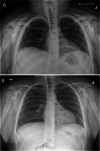Shrinking lung syndrome treated with rituximab in pediatric systemic lupus erythematosus: a case report and review of the literature
- PMID: 33407629
- PMCID: PMC7789161
- DOI: 10.1186/s12969-020-00491-0
Shrinking lung syndrome treated with rituximab in pediatric systemic lupus erythematosus: a case report and review of the literature
Abstract
Background: Shrinking lung syndrome (SLS), a rare complication of systemic lupus erythematosus (SLE) characterized by dyspnea, low lung volumes, and a restrictive pattern on pulmonary function tests (PFTs), has only been reported in a few children. Given the rarity of SLS there is a paucity of literature regarding its optimal treatment. Outcomes are variable, with case reports documenting some improvement in most patients treated with corticosteroids, with or without additional immunosuppressive agents. However, most reported patients did not recover normal lung function. We report full recovery of a child with SLE and SLS following treatment with rituximab and review the current literature.
Case presentation: An 11-year-old boy presented with a malar rash, myositis, arthritis, oral ulcers, leukopenia, anemia, positive lupus autoantibodies and Class II nephritis. He was diagnosed with SLE and treated with corticosteroids, hydroxychloroquine, azathioprine, and subsequently mycophenolate with symptom resolution. At age 14, his SLE flared coincident with a viral chest infection. He presented with a malar rash, polyarthritis, increased proteinuria and pleuritis which all improved with corticosteroids and ongoing treatment with mycophenolate. Six weeks later he presented with severe dyspnea, markedly decreased lung volumes, but otherwise normal chest X-ray (CXR) and high-resolution chest computed tomography (HRCT). He was found to have severely restricted PFTs (FEV1 27%, FVC 29%; TLC 43%). After additional investigations including echocardiography, pulmonary CT angiography, and diaphragmatic fluoroscopy, he was diagnosed with SLS and treated with rituximab and methylprednisolone. At 1 month his symptoms had improved, but he still had dyspnea with exertion and severely restricted PFTs. At 6 months his FVC and TLC had improved to 51 and 57% respectively, and were 83 and 94% respectively at 4 years. He had returned to all baseline activities, including competitive hockey.
Conclusions: Although extremely rare, it is important to recognize SLS as a possible cause of dyspnea and chest pain in a child with SLE. Optimal treatment strategies are unknown. This is the second reported case of a child treated with rituximab for SLS who recovered normal lung function. International lupus registries should carefully document the occurrence, treatment and outcome of patients with SLS to help determine the optimal treatment for this rare complication.
Keywords: Child; Lung; Lupus; Rituximab; SLE.
Conflict of interest statement
The authors declare that they have no competing interests.
Figures



Similar articles
-
Rituximab in the treatment of shrinking lung syndrome in systemic lupus erythematosus.Reumatol Clin. 2014 Sep-Oct;10(5):325-7. doi: 10.1016/j.reuma.2013.09.003. Epub 2013 Dec 4. Reumatol Clin. 2014. PMID: 24315464
-
Successful treatment of shrinking lung syndrome with rituximab in a patient with systemic lupus erythematosus.J Clin Rheumatol. 2010 Mar;16(2):68-70. doi: 10.1097/RHU.0b013e3181d0757f. J Clin Rheumatol. 2010. PMID: 20216126
-
Shrinking lung syndrome in systemic lupus erythematosus: a single-centre experience.Lupus. 2018 Mar;27(3):365-371. doi: 10.1177/0961203317722411. Epub 2017 Jul 31. Lupus. 2018. PMID: 28758573
-
Shrinking lung syndrome in systemic lupus erythematosus: A case series and review of the literature.Medicine (Baltimore). 2016 Aug;95(33):e4626. doi: 10.1097/MD.0000000000004626. Medicine (Baltimore). 2016. PMID: 27537601 Free PMC article. Review.
-
The shrinking lungs syndrome in systemic lupus erythematosus.Mayo Clin Proc. 2000 May;75(5):467-72. doi: 10.4065/75.5.467. Mayo Clin Proc. 2000. PMID: 10807075 Review.
Cited by
-
Pulmonary Involvement in Systemic Lupus Erythematosus: A Potentially Overlooked Condition.Biomedicines. 2025 Jun 16;13(6):1485. doi: 10.3390/biomedicines13061485. Biomedicines. 2025. PMID: 40564204 Free PMC article. Review.
-
Undercover lung damage in pediatrics - a hot spot in morbidity caused by collagenoses.Front Immunol. 2024 Jun 27;15:1394690. doi: 10.3389/fimmu.2024.1394690. eCollection 2024. Front Immunol. 2024. PMID: 38994372 Free PMC article. Review.
-
Shrinking Lung Syndrome as an Early Manifestation of Systemic Lupus Erythematosus: A Case Report With Literature Review.Respirol Case Rep. 2025 Jul 4;13(7):e70255. doi: 10.1002/rcr2.70255. eCollection 2025 Jul. Respirol Case Rep. 2025. PMID: 40625882 Free PMC article.
-
Shrinking Lung Syndrome: A Rare Pulmonary Complication of Systemic Lupus Erythematosus.Cureus. 2024 Jul 6;16(7):e63990. doi: 10.7759/cureus.63990. eCollection 2024 Jul. Cureus. 2024. PMID: 39109103 Free PMC article.
References
-
- Duron L, Cohen-Aubart F, Diot E, Borie R, Abad S, Richez C, et al. Shrinking lung syndrome associated with systemic lupus erythematosus: a multicenter collaborative study of 15 new cases and a review of the 155 cases in the literature focusing on treatment response and long-term outcomes. Autoimmun Rev. 2016;15:994–1000. doi: 10.1016/j.autrev.2016.07.021. - DOI - PubMed
Publication types
MeSH terms
Substances
LinkOut - more resources
Full Text Sources
Other Literature Sources
Medical

